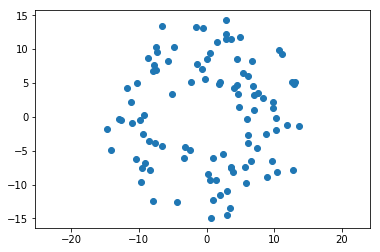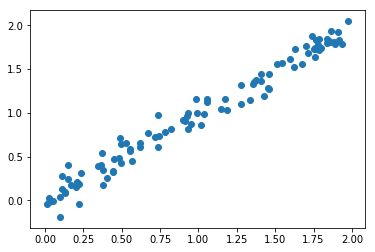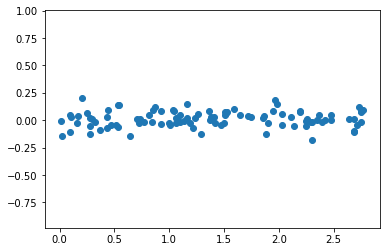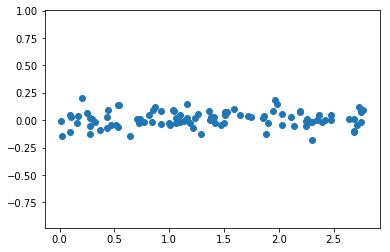반응형
Notice
Recent Posts
Recent Comments
Link
| 일 | 월 | 화 | 수 | 목 | 금 | 토 |
|---|---|---|---|---|---|---|
| 1 | ||||||
| 2 | 3 | 4 | 5 | 6 | 7 | 8 |
| 9 | 10 | 11 | 12 | 13 | 14 | 15 |
| 16 | 17 | 18 | 19 | 20 | 21 | 22 |
| 23 | 24 | 25 | 26 | 27 | 28 | 29 |
| 30 |
Tags
- inorder
- 자료구조
- web 사진
- bccard
- mglearn
- web 용어
- java역사
- classification
- 데이터전문기관
- broscoding
- vscode
- 대이터
- KNeighborsClassifier
- C언어
- 결합전문기관
- web 개발
- 웹 용어
- 머신러닝
- paragraph
- pycharm
- CES 2O21 참가
- 재귀함수
- html
- tensorflow
- web
- postorder
- CES 2O21 참여
- Keras
- discrete_scatter
- cudnn
Archives
- Today
- Total
bro's coding
sklearn.preprocessing.MinMaxScaler, StandardScaler, Normalizer 본문
[AI]/python.sklearn
sklearn.preprocessing.MinMaxScaler, StandardScaler, Normalizer
givemebro 2020. 4. 20. 17:40반응형
- StandardScaler : 각 속성들을 평균이 0, 표준편차가 1이 되도록 조정
- MinMaxScaler : 최소값이 0, 최대값이 1이 되도록 비율을 조정
- Normalizer : 속성(열)이 아니라 각각의 샘플(행)의 유클리디안 길이가 1이 되도록 조정 (지름이 1인 구 표면에 각각의 샘플을 투영)
import numpy as np
import pandas as pd
import matplotlib.pyplot as plt
X = np.arange(12).reshape(4,3)
X
'''
array([[ 0, 1, 2],
[ 3, 4, 5],
[ 6, 7, 8],
[ 9, 10, 11]])
'''
# 각 속성(열)의 범위를 0~1 로 제한하고 싶을 경우
X_max = X.max(axis=0)
X_min = X.min(axis=0)
X_ms = (X-X_min) / (X_max-X_min)
X_ms
'''
array([[0. , 0. , 0. ],
[0.33333333, 0.33333333, 0.33333333],
[0.66666667, 0.66666667, 0.66666667],
[1. , 1. , 1. ]])
'''
# 각 속성(열)을 정규분표(평균이 0, 표준편차가 1)로 바꾸고 싶을 경우
X_mean = X.mean(axis=0)
X_std = X.std(axis=0)
X_ss = (X-X_mean) / X_std
X_ss
'''
array([[-1.34164079, -1.34164079, -1.34164079],
[-0.4472136 , -0.4472136 , -0.4472136 ],
[ 0.4472136 , 0.4472136 , 0.4472136 ],
[ 1.34164079, 1.34164079, 1.34164079]])
'''
# 각 샘플(행)의 길이를 1로 바꾸고 싶을 경우
X_dist = np.sqrt((X**2).sum(axis=1)) # 각 행의 길이를 구한다
X_ns = X / X_dist.reshape(-1,1) # reshape() 로 열 벡터로 변환
X_ns
'''
array([[0. , 0.4472136 , 0.89442719],
[0.42426407, 0.56568542, 0.70710678],
[0.49153915, 0.57346234, 0.65538554],
[0.5178918 , 0.57543534, 0.63297887]])
'''
c1 = np.random.uniform(0,np.pi*2, size=100)
c2 = np.random.uniform(5,15,size=100)
X = np.c_[c2*np.cos(c1),c2*np.sin(c1)]
plt.scatter(X[:,0], X[:,1])
plt.axis('equal')
from sklearn.preprocessing import MinMaxScaler, StandardScaler, Normalizer
ms = MinMaxScaler()
ms.fit(X)
ms.transform(X)
#ms.fit_transform(X)
'''
array([[0. , 0. , 0. ],
[0.33333333, 0.33333333, 0.33333333],
[0.66666667, 0.66666667, 0.66666667],
[1. , 1. , 1. ]])
'''
ss = StandardScaler()
ss.fit_transform(X)
'''
array([[-1.34164079, -1.34164079, -1.34164079],
[-0.4472136 , -0.4472136 , -0.4472136 ],
[ 0.4472136 , 0.4472136 , 0.4472136 ],
[ 1.34164079, 1.34164079, 1.34164079]])
'''
ns = Normalizer()
ns.fit_transform(X)
'''
array([[0. , 0.4472136 , 0.89442719],
[0.42426407, 0.56568542, 0.70710678],
[0.49153915, 0.57346234, 0.65538554],
[0.5178918 , 0.57543534, 0.63297887]])
'''
ss.fit(X_train)
ss.transform(X_train)
ss.transform(X_test)
# 학습세트와 테스트세트가 분리하였을 때,
# 학습세트를 가지고 스케일 조정에 대한 기준을 만든 다음 그 기준에 따라 테스트세트를 조정
# 회전변환
xs = np.random.uniform(0,2,size=100)
ys = xs + np.random.normal(0, 0.1, size=100)
plt.scatter(xs, ys)
xs2 = xs * np.cos(np.pi/4) + ys * np.sin(np.pi/4)
ys2 = -xs * np.sin(np.pi/4) + ys * np.cos(np.pi/4)
plt.scatter(xs2, ys2)
plt.axis('equal')

X = np.c_[xs, ys]
theta = -np.pi/4
tf = [[np.cos(theta), np.sin(theta)], [-np.sin(theta), np.cos(theta)]] # 회전변환 행렬
X_rot = np.matmul(X, tf) # 행렬곱
plt.scatter(X_rot[:,0], X_rot[:,1])
plt.axis('equal')
반응형
'[AI] > python.sklearn' 카테고리의 다른 글
| sklearn.decomposition.PCA.basic (0) | 2020.04.21 |
|---|---|
| sklearn.cluster.DBSCAN (0) | 2020.04.21 |
| sklearn.datasets.make_moons (0) | 2020.04.21 |
| sklearn.cluster.KMeans.basic (0) | 2020.04.21 |
| sklearn.RandomForestClassifier.feature_importances_(중요도 표현) (0) | 2020.04.20 |
| sklearn.ensemble.RandomForestClassifier.2 feature for visualization (0) | 2020.04.20 |
| sklearn.ensemble.RandomForestClassifier.basic (0) | 2020.04.20 |
| sklearn.install graphviz (0) | 2020.04.20 |
Comments




